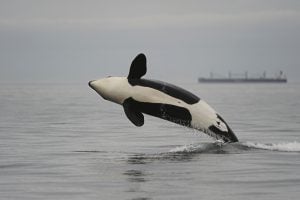A British Columbia group is calling on the federal government to relax regulations on commercial seal and sea lion hunting on the province’s west coast, arguing that the seal population needs to be brought back into balance to protect fish stocks.
The Pacific Balance Pinnipeds Society is composed of First Nations groups as well as commercial and sport fishers. They propose to cut the province’s pinniped population in half, with thousands hunted each year; in so doing, they hope to create a new industry that could employ up to 4,000 people. They say that reducing predation pressure on declining populations of chinook salmon would also benefit endangered southern resident killer whales. The southern resident killer whales are a group of 75 animals that frequently congregate between southern Vancouver Island and northern Washington State and feed predominantly on chinook salmon. They are genetically and socially distinct from other groups of killer whales.
But some scientists worry that culling seals might have unintended effects on the wider ecosystem, including on transient killer whales. Unlike their resident relatives, transient killer whales eat mammals, including seals, and travel more widely along the coast. Canadian Geographic spoke to Dr. Andrew Trites, head of the Marine Mammal Research Unit at the University of British Columbia, to get his perspective on the seal hunt debate.
CG: One of the arguments in favour of reopening the seal hunt is that there are too many seals in B.C. What kind of numbers are we talking about?
AT: We’re talking about a population of harbour seals that numbers about 105,000 animals. To put that into perspective, B.C. Place — the stadium where people go to watch football and soccer — holds 55,000 people. So you could put more than half of all seals in that one building and they could each have a seat. When we spread that number of seals over the entire coast, it’s not that many. The fact is that they are already in balance; it’s just not a balance that some people like.
CG: What’s the current population trend for seals?
AT: We commonly hear about how the seal population has increased tenfold, but that’s because prior to the 1970s they were hunted and culled to the point that it was very rare that anybody ever saw seals. Once they were protected by the Fisheries Act in 1971, their numbers began to increase. They increased quite rapidly through the 80s and into the 90s and then just stopped in 1999. They’ve been at carrying capacity ever since. We commonly think of a population that’s at carrying capacity — that has stopped growing — as in balance.
CG: Why has the population stopped growing?
AT: It’s been a big puzzle as to why seal numbers have stopped increasing and the best explanation we have is because of predation by transient killer whales. That’s a type of killer whale that only eats marine mammals. It used to be quite rare to see a transient killer whale. People in the Salish Sea saw the resident killer whales, which eat salmon, but hardly ever saw transients. Today, they are seen every single day. The Salish Sea has become probably the most important grocery store stop for these whales because that’s where the seals are. So the fact is that the transient killer whales are doing what the Pinniped Society wants and balancing the numbers of pinnipeds.
CG: What impact do seals have on chinook salmon populations?
AT: The studies that have been done to date indicate that seals do eat some adult fish when they’re returning to spawn. But the fish are coming back in such huge numbers that they swamp the predator. We’ve got no evidence that they’re eating too many adults and therefore having impacts on the populations. Seals are not the only predator of salmon but they’re often the only scapegoat. There’s still more for science to figure out.
CG: How might a seal cull impact other marine mammals?
AT: One of the arguments from the Pacific Balance Pinniped Society is that we need to kill the seals so there is more adult salmon for southern resident killer whales — which would be great. But when you remove half the food supply of the transient killer whales, you’re probably going to reduce their population by half. We’re going to see animals that are looking emaciated, potentially starving. We’re also going to find increased predation on other types of marine mammals, such as the harbour porpoise and Dall’s porpoise. The transients might be motivated to start attacking the calves of humpback whales. So, removing seals to add more salmon to the system to feed southern resident killer whales could actually have dire consequences for all the other marine mammals in the ecosystems.
CG: As a researcher, what questions do you think should be asked when weighing the prospect of a cull?
AT: When I look out here, I see overall a very healthy ecosystem, in terms of the marine mammals that are here. The southern resident killer whales are an outlier. But that balance that has been established would be ironically turned on its head by what the Pacific Balance Pinniped Society is currently proposing, if it was to go ahead. I think it’s important for society to have this discussion about what it is that we want to see. How do we want to share the ocean? Do we want to let nature balance itself? Or does it actually need a human hand to change it in ways we think will benefit people at the expense of ocean life?





